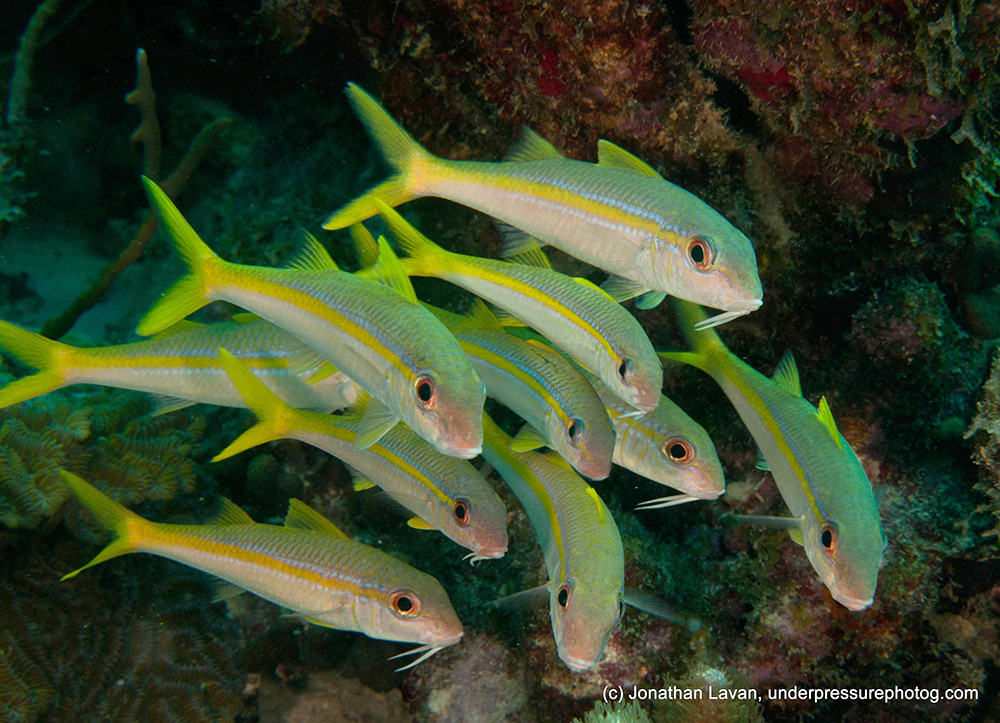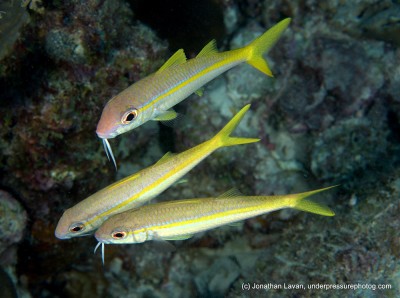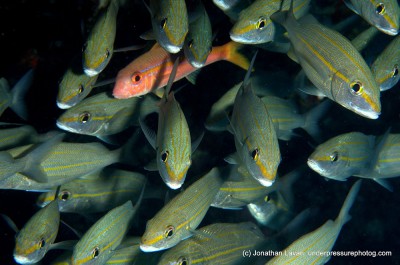Caribbean Creature Feature: Yellow Goatfish
Apr 14
The Opportunistic Omnivores –
There are Goatfish in all warm water oceans and some temperate waters as well. In the Caribbean we find the Spotted Goatfish, the Red Goatfish, the Dwarf Goatfish (seldom seen) and the Yellow Goatfish that we will be looking at today. Not unlike the barnyard animal that is their namesake, Yellow Goatfish will eat just about anything. This is always a good strategy when trying to survive, and while the sand flats may be where you tend to find Yellow Goatfish, they will often explore all areas of the reef in search of food. Typically, you see smaller schools of larger adults sifting through the sand with their barbels (chin whiskers), a single fish shadow feeding (two different species) or nuclear hunting (three or more species) with other kinds of fish. In Bonaire, where photos 1 & 2 were taken, there seems to be a preponderance of schooling juveniles exploring the upper part of the reef, and during my trip I never saw them feeding in the sand like their adult counterparts, which is unusual.

From the “neck” down Yellow Goatfish look exactly like Yellowtailed Snappers, but there is little room for confusion if you compare their faces. Yellowtailed Snapper have the typical fish face – pointed snout and a small eye. Yellow Goatfish on the other hand, have what can only be termed a schnozolla – a large, prominent nose, a much larger red eye and those unforgettable barbels on their chin. These chin whiskers are a major sensory organ of touch for the Yellow Goatfish and you will see them constantly wiggling them across the ground or through the sand in search of any type of food they can find. If you’re lucky, you may also see two of them approach each other head to head and wiggle their barbels together as if shaking hands Yellow Goatfish style!
Our last photo is fairly unusual. Here we see a Yellow Goatfish infiltrating a school of Tomtate Grunts. Notice also that it is wearing its night colors. Many fish will change color or pattern at night to aid in protective camouflage. Red is a particularly good color as it is almost invisible in the dark. That is why many nocturnal fish are red, including Squirrel, Soldier and Cardinalfish. But back to our Goatfish. It’s swimming around in brightly sunlit water at midday, so why is this fish in the middle of a school of a different species wearing its pajamas? Does it think like a small child covering its face with its hands that it can’t be seen? Does it think it’s “making a hole in the water”? Only the Yellow Goatfish knows for sure.

When they are not feeding, which tends to be quite a quick activity, Goatfish will often drift around in large lazy schools or aggregations over the sand or nearby reefs. This gives the beginner or intermediate photographer a good opportunity to get some good shots. As always, start shooting on the approach but no farther away than four feet or so. In conclusion, the fish that you see on every dive during your liveaboard trip and perhaps take for granted or barely notice, can be one of the more interesting and charismatic fish swimming around your favorite Caribbean coral reef.
By: Jonathan Lavan
Jonathan Lavan: The owner/operator of Underpressure Diving & Nature Photography is a citizen scientist and wildlife expert and has been SCUBA Diving for thirty years and taking photographs both above and below the water for about 10. He was pleased to have been made Volunteer of the Year for 2012 by the Reef Environmental Education Foundation. As a SCUBA Diver he has been a photographer, teacher and research associate for many different organizations.He is a staunch environmentalist and educator of young people. Jonathan is committed to making a difference on this planet through his images and his message of good will to all creatures. www.underpressurephotog.com.





Related Articles
Popular Articles